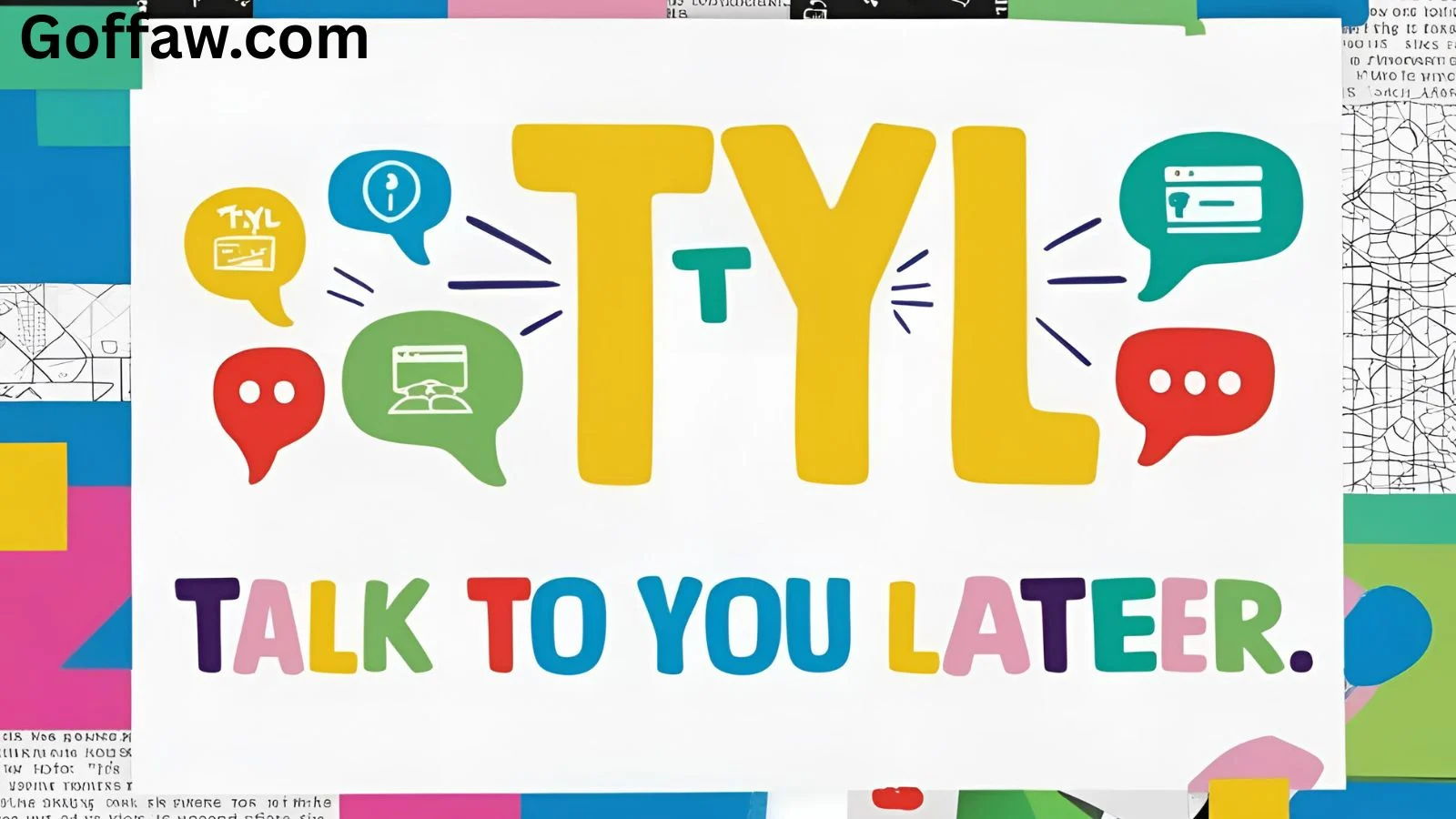In today’s fast-paced digital world, shorthand and acronyms dominate online messaging.
Whether you’re texting a friend or responding to a colleague, knowing what these abbreviations mean—and how to use or replace them appropriately—is vital for effective and respectful communication.
One of the most common acronyms you’ll encounter in casual messaging is “TTYL.” But what does it really mean? And is it always appropriate to use?
This in-depth article explores the meaning of “TTYL”, its nuances, and 11 powerful alternatives that you can use in both formal and informal situations. We’ll also guide you through the tone, context, and appropriate usage of each phrase so that you always leave the right impression.
What Does TTYL Mean?
TTYL stands for “Talk To You Later.”
It’s a casual, friendly way to say goodbye at the end of a conversation—especially over text, instant messaging, or social media.
This abbreviation gained popularity in the early days of texting and online chatrooms, and it’s still used frequently in informal conversations. However, in more professional or serious settings, “TTYL” may come across as too casual or unprofessional, which is why learning a few well-crafted alternatives can elevate your communication style.
Tone and Context: When to Use or Avoid “TTYL”
Before diving into alternatives, it’s essential to understand the tone behind “TTYL” and when it’s appropriate (or inappropriate) to use.
✅ Use “TTYL” When:
- Texting friends or peers.
- Ending a casual online conversation.
- You expect to speak again soon.
- You want a short, friendly sign-off.
❌ Avoid “TTYL” When:
- Messaging a supervisor, client, or business contact.
- Communicating in formal emails or reports.
- Closing a conversation where timing for follow-up is uncertain.
- You want to sound mature or emotionally sensitive.
The bottom line? “TTYL” is relaxed and friendly—but not versatile. That’s where alternatives come in.
11 Best Alternatives to “TTYL” (With Meaning and Examples)
Let’s explore 11 thoughtful ways to say “Talk to you later” depending on tone and situation. These alternatives range from casual to formal and can be used based on your relationship with the recipient.
1. Talk Soon
Meaning: You’re planning to reconnect in the near future.
Tone: Friendly, slightly more polished than “TTYL.”
Context: Use with friends, coworkers, or casual business chats.
Example:
“Thanks for the update! Let’s talk soon.”
This phrase offers a natural flow and leaves the door open for further conversation without being overly casual.
2. Catch You Later
Meaning: Informal goodbye, implies you’ll see or talk again.
Tone: Casual and breezy.
Context: Ideal for friends or informal messages.
Example:
“Alright, gotta run. Catch you later!”
This has a laid-back vibe, often used in spoken conversation as well.
3. Speak With You Later
Meaning: A slightly more professional variation of “Talk to you later.”
Tone: Neutral, respectful.
Context: Appropriate for work emails or messages.
Example:
“I’ll check in after the meeting. Speak with you later.”
It strikes the balance between polite and personal, ideal in semi-formal communication.
4. I’ll Get Back to You Soon
Meaning: Suggests that you’ll respond or follow up later.
Tone: Considerate and responsible.
Context: Useful in customer service, team settings, or project management.
Example:
“Thanks for sharing the draft. I’ll get back to you soon.”
This one shows attentiveness and respect for the ongoing discussion.
5. Chat Later
Meaning: You’ll talk again, but in a relaxed and informal way.
Tone: Playful and casual.
Context: Great for friends, peers, or relaxed environments.
Example:
“Busy at the moment—chat later?”
This short and sweet phrase is easy to type and easygoing in tone.
6. Let’s Continue This Later
Meaning: You want to pause the conversation and resume later.
Tone: Direct but polite.
Context: Excellent when you’re short on time but don’t want to appear dismissive.
Example:
“This is interesting—let’s continue this later.”
It expresses genuine interest while setting a boundary.
7. Until Next Time
Meaning: A graceful way to say goodbye, with no strict timeline.
Tone: Warm and thoughtful.
Context: Suitable for acquaintances, clients, or new friends.
Example:
“That was a lovely chat. Until next time!”
This is particularly useful when you’re unsure when you’ll speak again but want to part kindly.
8. Let’s Catch Up Soon
Meaning: Indicates your intention to reconnect and share updates.
Tone: Friendly and proactive.
Context: Good for friends, colleagues, or distant contacts.
Example:
“Missed talking to you! Let’s catch up soon.”
This alternative has an engaging feel, showing you value the relationship.
9. I’ll Be in Touch
Meaning: You’ll reach out again at a later point.
Tone: Professional, clear, and polite.
Context: Excellent for work emails or networking.
Example:
“Thanks for the meeting. I’ll be in touch with next steps.”
It shows follow-through and accountability—perfect for maintaining business relationships.
10. Take Care for Now
Meaning: A gentle goodbye, wishing someone well.
Tone: Warm and kind.
Context: Appropriate in personal and semi-formal settings.
Example:
“I enjoyed our conversation—take care for now.”
It leaves a positive tone at the end of a message.
11. Message You Later
Meaning: You intend to reach out again via message.
Tone: Informal, casual.
Context: Great for texting or instant messaging with friends.
Example:
“Heading out—message you later!”
This is a modern spin on “TTYL” that feels updated and specific.
How to Choose the Best Alternative to TTYL
Selecting the best way to say “Talk to you later” isn’t just about replacing three letters—it’s about choosing the right tone, context, and intention.
Here’s how to decide:
🗣️ Consider the Relationship
- Talking to a close friend? “Catch you later” or “Chat later” works well.
- Talking to your manager or a client? Choose “Speak with you later” or “I’ll be in touch.”
💼 Consider the Setting
- In a business email, professionalism matters.
- In a DM or group chat, you can afford to be relaxed and brief.
🧠 Think About the Message You Want to Send
- Do you want to sound caring? Use “Take care for now.”
- Want to leave a door open for reconnecting? Go with “Let’s catch up soon.”
When you pause for just a second and pick the right farewell, you’ll leave a lasting impression—whether in a quick chat or a long exchange.
Why You Should Master These Alternatives
In a world that’s constantly messaging, words carry weight—even short ones. The difference between sounding respectful or rushed, professional or too playful, often lies in how you say goodbye.
Using alternatives to “TTYL” gives you more control over your message and helps you connect better with your audience. Whether it’s impressing a potential client, maintaining a strong friendship, or simply sounding like your best self, these small adjustments matter.
And guess what? They elevate your communication game from average to excellent.
Final Thoughts:
“TTYL” is short, sweet, and familiar—but not always the best fit.
By learning versatile, audience-appropriate alternatives, you show emotional intelligence, professionalism, and respect—all of which go a long way in today’s communication-driven world.
Next time you’re about to end a chat or send a message, try switching things up. Say more with fewer words, and leave your conversation partner feeling respected, heard, and ready to reconnect.




